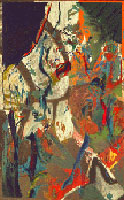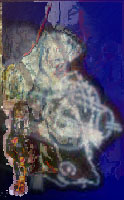


Potter's Field
1995
above: Subsurface images of deep layerd of the Potter's Field, ca. 2.5m down. Taken over the course of 18 months (left to right), these strata show evidence of advanced decomposition. All views are color-enhanced with a focal depth of approx. 2.5 inches.
Potter's Field is a free burial ground for art that is too impoverished, friendless, or worthless to be entombed in a museum, including both original works and fakes of all kinds. It is so named because, like the traditional potter's field, it serves as a public burial place for the poor, the unknown, and the prohibited. Potter's Field also serves as a conceptual model for real-world burial grounds that could be established to respectfully dispose of the 99.99% of all artworks that never make it into a permanent gallery.
Research findings: Shortly after the Potter's Field site was set up, attendants discovered that decomposition of art does not occur in a straightforward way. Several works that were dug up for reburial due to partial collapse of the underlying strata were found to have migrated from their original positions. It appears that they had been cannibalizing or colonizing one another. Museum researchers now speculate that art has strongly viral properties and is probably not an aesthetic form at all.
